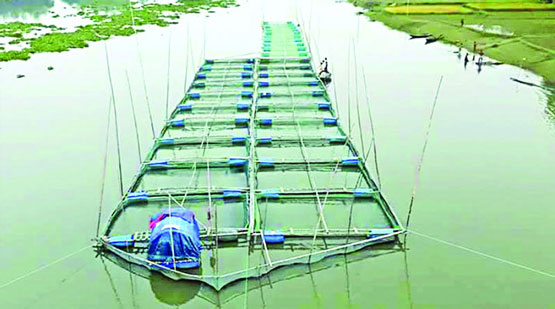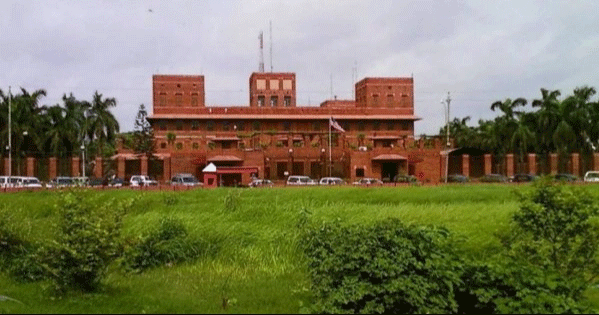BD achieves remarkable success in fish production
Scores 3rd position for 3rd time
Mahfuja Mukul: Fish production has increased more than six times in 38 years. The GDP growth in fisheries sector is 5.74 percent. Fisheries sub-sector contributes 3.57 percent of the country’s total GDP, 26.50 percent of the agricultural GDP.
The country’s fisheries and livestock sector continue to play an effective role in food and nutrition security of safe animal and non-vegetarian production, entrepreneurship, employment generation, poverty alleviation and rural economy. The contribution of the fisheries sector to rural economic progress, prosperity and above all poverty alleviation is undeniable. Despite the Corona crisis, the production, supply and marketing of fish, meat, milk, eggs in the country have been kept normal.
According to the latest data of the Food and Agriculture Organization of the United Nations, Bangladesh is one of the three countries in the world that have shown success in fish production despite the Corona virus.
According to the Food and Agriculture Organization of the United Nations (FAO) global report titled ‘The State of World Fisheries and Aquaculture 2022’, Bangladesh now ranks third in the world (fifth for six years) in farmed fish production, which is considered a unique achievement of the fisheries sector in 2022.
Those concerned.
According to the Ministry of Fisheries and Livestock, 1.95 million or more than 12 percent of the total population of the country, including 1.4 million women, earn their living directly or indirectly by working in the fisheries sector.
Bangladesh achieved self-sufficiency in fish production in 2016-17 financial year. By increasing the sustainable production of fish and shrimp and other aquatic resources, the government is working to meet the nutritional needs of the country and increase the export income, and through the proper management of the open water bodies with the participation of the target population, the poor fishermen and fish farmers and the socio-economic development of Bangladesh.
Success of fisheries sector
In the fiscal year 2021-22, fish production was 47.59 lakh metric tons; Which is 55.42 percent more than the total production of 2010-11 fiscal year (30.62 lakh metric tons). In 1983-84 the total production of fish in the country was 7.54 lakh metric tons.
At present, 1.24 percent of the country’s export income comes from the fisheries sector. Fish is exported to more than 50 countries in the world. In the last fiscal year 2021-22, 78 thousand 42.67 metric tons of fish and fish products have been exported earning 5 thousand 191.75 crore taka, which is 26.96 percent more than the previous year.
With the aim of supplying healthy and safe fish and fish products to the domestic market as well as the international market of the country, three international standard fish quality control laboratories are being established and operated under the Directorate of Fisheries. The Fisheries and Fishery Products Quality Control Act 2020 has been enacted.
Bangladesh now ranks third in the world in freshwater fish production. It is in the first position in the production of hilsa (currently the total production of hilsa is 5.71 lakh metric tons).
In the development of the green economy, initiatives have been taken to explore, conserve and sustainably harvest conventional and non-conventional fisheries in the sea. Formulation of short, medium and long-term marine fisheries development strategies and updating them in coordination with the SDGs. In the meantime, Marine Fisheries Act 2020 and Marine Fisheries Rules 2022 have been formulated.
10,000 artisanal fishing boats and 5 commercial fishing boats have been brought under the technology-based vessel monitoring system to strengthen monitoring, control and surveillance in the country’s sea limits.
As a part of fish conservation, breeding techniques and farming methods have been developed for 37 species of native endangered fish. A live gene bank of indigenous fish has been established for the first time. So far 102 species of fish have been preserved in the gene bank.
BFRI Suvarna Roi, a fast growing and highly productive new breed of Roi fish has been developed.
Identity cards to fishermen
Till now 17 lakh 37 thousand 786 fishermen-fishermen have been registered and identity cards have been distributed to 14 lakh 20 thousand fishermen. 16 lakh 20 thousand fishermen register and database prepared. Registration of fishermen under revenue sector is ongoing.
During the period 2012-13 to 2016-17, a total grant of Tk 2.89 lakh 70 thousand has been paid to 587 fishermen families who died due to natural calamities (storms, cyclones, floods) and pirate attacks, tiger claws, crocodile and snake bites through the development scheme.
According to the ‘Policy on providing financial assistance to families of deceased fishermen or permanently disabled fishermen-2019’, a total financial assistance of Tk 26.50 crore has been provided.
Expansion of non-traditional fisheries
Establishment of crab hatchery and successful production of crablets: In order to expand coastal aquaculture and mariculture in the country, a crab hatchery has been set up at Kalatali, Cox’s Bazar and crablets are being successfully produced.
Sea-weed and western culture piloting: Sea-weed and western culture piloting is being done in 0.8 hectare coastal area of Sadar upazila, Teknaf, Maheshkhali and Ukhia upazilas of Cox’s Bazar district.
In this regard, Fisheries and Livestock Minister S M Rezaul Karim told Daily Industry that Bangladesh has achieved self-sufficiency in fish production due to various initiatives and effective measures taken by the government under the visionary leadership of Prime Minister Sheikh Hasina. This unique achievement is due to the adoption and implementation of timely plans for the production and management of inland open water bodies, inland water bodies and marine water bodies.
As a result of the successful implementation of the government’s long-range planning and development projects in the fisheries sector, the increase in fish production over the past decade was significant. This success in the fisheries sector of the country has been possible due to various steps including establishment of fish sanctuaries, implementation of fisheries laws, effective management for the development of hilsa resources, development of research in the fisheries sector, innovation and expansion of indigenous fish farming technology, innovation and expansion of new varieties.
He said that the total production of fish in the country was 8.14 lakh metric tons in the fiscal year 1971-72. In 50 years of independence, fish production has increased more than five and a half times. In the fiscal year 2020-21, fish production has reached 46.21 lakh metric tons, which is 50.91 percent more than the total production in the fiscal year 2010-11. This achievement of the country’s fisheries sector has been recognized in the international arena.
According to the global report titled ‘The State of World Fisheries and Aquaculture 2022’ of the Food and Agriculture Organization of the United Nations (FAO), Bangladesh has now achieved the third position in the world in the production of farmed fish. Only India and China are ahead of Bangladesh. Bangladesh was in the fifth position for six years.
This achievement is very proud and honorable. Besides, according to the FAO report, Bangladesh ranks third in inland water catchment, 8th and 11th in production of marine and coastal crustaceans and finfish, respectively. Besides, Bangladesh is the first among 11 countries producing hilsa in the world, Bangladesh ranks fourth in the world and third in Asia in tilapia production.
President Joe Biden tests positive for COVID-19 while campaigning in Las Vegas, has ‘mild symptoms’
International Desk: President Joe Biden tested positive for COVID-19 while traveling Wedne…








